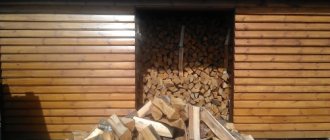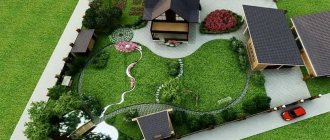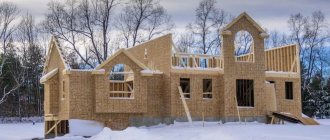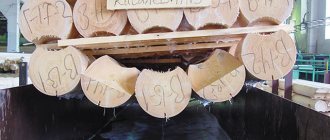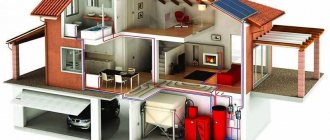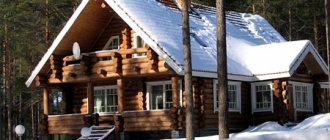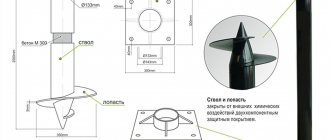The summer season is coming to an end. Many city dwellers are ready to come to their dacha in winter, but cannot solve the heating issue. We want to introduce you to the most common methods of heating a country house during the cold season.
We do not live in those latitudes where in winter the sun “distributes” heat for free. We have to pay for it: either with money or with our own labor. How can we heat our home?
The cheapest way is to use firewood, but we definitely need to put a lot of work into it. A simpler, but more expensive option is gas. The simplest and most expensive heating option is electricity. Which method is best for a country house?
Heaters
Depending on the operating principle and heat source, heaters are divided into oil, infrared, gas, etc.
Oil heater
What is an oil heater? This is the reservoir in which the heating element is located. Oil is also poured in there. Oil was not chosen as a coolant by chance: it takes a long time to heat up, but then, after maximum heating, it is able to maintain a high temperature for a long time.
This device has other advantages:
- relatively low price;
- mobility (unlike a battery, the heater can be moved to any place in the room or country house);
- there are no foreign odors or noise during its operation;
- When heating, it does not dry out the air in the room.
The disadvantages include the following:
- the oil heats up very slowly, so you will have to wait a long time for the air in the room to warm up. Oil heaters equipped with a fan do not have this drawback, although they are more expensive;
- Due to the massive body and the oil poured into the tank, these devices are quite heavy. If you have a two-story cottage, then when moving the device from one floor to another this can turn into a big problem;
- Due to the high heating temperature of the housing, there is a risk of burns. This is especially important in families with children;
- considerable cost of energy consumption during prolonged heating of the heater.
Infrared heater
An infrared heater has a completely different operating principle. The temperature rise there occurs due to the action of infrared rays (hence the name). They act like the sun's rays: they pass freely through the air without heating it. When some “obstacle” (person, animal, furniture, etc.) is encountered along the way, infrared rays are absorbed by it, and at the same time the temperature of this object or living creature rises. Thus, infrared heaters do not warm the air, but us and all objects that are in their zone of action. And now we give this heat to the air, increasing its temperature.
Infrared heaters can be installed on any surface: floor, wall or ceiling. They have tip-over protection, which immediately turns off the device after a fall. They also have other advantages:
- these devices do not waste time on prolonged warming up, like oil devices, but begin to give off heat immediately after switching on;
- they operate silently, do not create odor and do not burn oxygen in the room;
- Many models have sensors that prevent the device from overheating and maintain the temperature at the level desired by the owner.
Infrared heaters are not without their disadvantages:
- quite high price compared to oil heaters;
- limited distance between the device and an object/person, beyond which the effect of the device is no longer felt;
- If you stay in the area of infrared rays for a long time, your health may deteriorate: headache, dry skin and eyes.
Convectors: electric and gas
A slightly different type of heating device, which is often used to heat country houses during the cold season, are convectors. The principle of their operation is based on the property of cold air to sink down, displacing warm air from there. The latter rises up, cools there and falls down again. This is how natural air circulation occurs - convection. She gave the device its name – convector.
An electric convector consists of a housing, in the upper and lower parts of which there are air intake openings. There is a heating element located inside the housing. Cold air enters the housing from below and flows around the heating element. At this time, its temperature rises, and a hot air flow comes out of the case through the upper holes, which immediately rises up to the ceiling. There it gives off its heat to the surrounding space, cools and sinks down again. This heats up the room.
Advantages of convectors:
- warms up the air in the room very quickly;
- unlike heaters, the body of convectors hardly heats up, so it is impossible to get burned on it;
- fairly low noise level;
- The temperature sensor helps control the heat level in the room and turns off the device when the desired temperature is reached. Thanks to this, energy savings occur.
There is nothing ideal in the world, so convectors also have disadvantages:
- while the convector is operating, the humidity level decreases, the air becomes very dry;
- high electricity consumption;
- Without a working convector, the air cools very quickly, so the device must be turned on constantly.
Stationary heating means with electricity
Electric cable or film floors are perfect for heating a dacha. True, you will have to incur costs for the purchase of heating elements and installation under the floor covering or in the screed. But such equipment starts easily from subzero temperatures, and it is also impossible to steal.
Disadvantages are long-term heating of the premises and the inability to heat water; this requires an electric boiler or a separate water heater.
The most convenient and functional traditional heating method is a water system with an electric boiler as a heat source. Its negative aspects are significant financial costs for installing the system and a long heating time for the building. In addition, during your absence, the water system is in danger of defrosting. But by installing a small indirect heating boiler in addition to the boiler, you can get hot water for household needs at your dacha.
To avoid defrosting, you need to purchase antifreeze, and use it to prepare and pour liquid into the heating system.
Important disadvantages of electric heating in general are the high electricity tariff and the limited power consumption limit. Regarding various heaters, you could see for yourself that they all have pros and cons; the appropriate option is selected individually.
Various types of stoves
Not many people can afford to build a large stationary stove in their dacha. The majority of summer residents prefer more compact options.
Potbelly stove
Known since the end of the 19th century, the stove has again begun to be in quite high demand in recent decades. Only this time the summer residents became interested in her. According to many of them, for the rare heating of a small country house, nothing better can be found.
The modern potbelly stove differs from its ancestors mainly in appearance. Its structure has remained virtually unchanged. It consists of a firebox (the size may vary), a vent and a chimney. Some models have a flat surface on top on which you can heat the kettle or cook some simple food. The material can be steel (cheaper options) and cast iron.
The advantages of this heating source:
- compactness, which is important for small country houses;
- quick heating of the room - for summer residents who rarely visit during the cold season of the year, this is one of the most important criteria when choosing a heating device;
- relatively low price;
- ease of operation;
- the ability to use not only firewood as fuel, but also wood chips, wood waste, branches, etc.
The potbelly stove also has disadvantages:
- as much as you heat, you warm up as much: the body of the potbelly stove heats up quickly, and cools down just as quickly;
- some models have a small firebox, so the size of the logs should not exceed 20 cm;
- it cannot be left unattended, and the reason is not only that you need to constantly add firewood, but also safety: a hot body can cause a fire;
- the stove gets very hot, so it needs to be located at a considerable distance from walls and any flammable objects, which is not very convenient in small rooms; for safe operation, the potbelly stove must be installed on a foundation (legs) or thermally insulated with flame and analogues from the nearest walls and floor;
- For combustion, the stove uses oxygen from the room, “taking” it from people. For this reason, in order to avoid oxygen starvation, ventilation is indispensable;
- Frequent chimney cleaning will also not be to the liking of many summer residents.
Stove Buleryan
At the end of the last century, a furnace was invented, which is still considered the best in terms of efficiency and productivity. It combines the operating principles of a potbelly stove and a convector. Like a potbelly stove, the Buleryan stove has a metal body, the base of which is a firebox for wood. Metal pipes are soldered into the structure. Cold air enters the bottom of each pipe. Circling around the combustion chamber, the cold air heats up and comes out of the top of the pipes already hot (the operating principle of a convector is used). Thanks to it, the room is heated.
Positive aspects of the Buleryan stove:
- the room warms up in a short period of time;
- low fuel consumption: one load of firewood is enough for 12 hours, because the wood in the stove does not burn, but smolderes slowly (it is known that smoldering wood provides more heat than actively burning wood);
- the stove does not heat up, so a separate foundation for it is not needed.
Disadvantages of the Buleryan stove:
- You need to use only completely dried firewood for the stove, otherwise the heat transfer of the fuel will be much lower;
- the oven becomes very clogged, so it has to be cleaned frequently; The reason for the appearance of a large amount of soot on the walls of pipes can also be wet firewood;
- To maintain a constant temperature in the room, you need to frequently adjust the position of the damper - this is unlikely to happen the first time. It takes time to learn how to operate the Buleryan stove;
- due to incomplete combustion of wood, smoke is released into the room; to avoid this and improve draft, the chimney should rise 3-5 m above the stove.
Stove-fireplace
A fireplace stove can be an excellent option for heating a country house in winter. This equipment combines the functions of a fireplace and stove. From the first it has a firebox, through which you can admire the bright burning flame. From the stove - heat emanating from the walls and warming the entire room quite evenly.
Fireplace stoves can be either stationary, made of brick and placed on a foundation, or more modern, made of cast iron or steel. They do not require a special foundation - a platform made of fireproof material is enough, they are easy to install and easier to dismantle in case of moving. Many models also have a hob where you can cook.
In addition to those listed, fireplace stoves have other advantages:
- rapid heating of the room;
- ease of installation of equipment when it comes to metal structures;
- most people receive aesthetic pleasure from the sight of burning wood and its smell;
- many modern models serve as interior decoration.
The disadvantages include the following:
- many models have a shallow firebox, which requires the preparation of small firewood;
- laying firewood is required several times a day: with intense combustion, the fuel lasts only a few hours;
- heating of the room occurs unevenly: warm air rushes upward, and at the same time it can be quite cold below.
What to look for when choosing?
- The most important part of the convector is the heating element. It is wiser to give preference to a monoblock design, the lifespan of which is 10–25 years.
- Electrical wires going to the heating element should not pass through the heating zone and bend over the edge of the metal sheet.
- The power button, located at the bottom of the case, is not very convenient; it is better if it is at the top, then you don’t have to bend down to control the device. The same goes for the thermostat.
- The thickness of the walls plays an important role - the thicker it is, the less the risk of damaging the heater in case of an accidental impact.
- Finally, it is useful to pay attention to the design of the brackets with which the device is fixed to the wall. Some models have movable fasteners, allowing you to easily remove them if necessary or tilt them away from the wall if you need to wash the back panel.
Read more in the material “Fast Heat”.
2
Gas equipment: heaters and convector
In addition to firewood and electricity, there is another source of thermal energy that many summer residents successfully use - gas. If gas is not supplied to your dacha, you can use liquefied gas (it is supplied in cylinders): currently, many heating devices can operate on any of these types of fuel. Equipment that runs on gas in a country house is used:
- infrared gas heater,
- gas convectors,
- catalytic gas heater.
The operating principle of the first two devices is no different from their counterparts powered by electricity. But the action of a catalytic heater is based on the interaction of burning gas with a special catalyst plate. During combustion, the gas, thanks to the catalyst, is oxidized. The oxidation reaction is accompanied by the release of a large amount of heat, which warms the room. Gas consumption is quite small, because the oxidation reaction depends simply on combustion, and not on its power.
Advantages of gas equipment:
- fairly low gas prices;
- ease of installation, mobility;
- rapid heating of the room;
- reliability.
Not without its drawbacks:
- when using gas cylinders there is always a risk of gas leakage;
- at low temperatures there may be a problem with turning on the gas heater;
- infrared gas heaters are quite expensive, and if they break down, repairing them will also cost you a pretty penny;
- When gas is burned in convectors, combustion products are formed, for the removal of which a chimney is required;
- Catalytic heaters have practically no combustion products, but they have another disadvantage - a limited service life. When using low-quality gas, it is greatly reduced.
Operating principle of the steam system
In order for a high-pressure steam boiler to function normally, water treated with chemicals is used. It is heated by packages of screen pipes. Vapors appear due to fuel combustion.
The steam heating system works according to the following principle:
- Install a boiler that runs on electricity or solid or liquid fuel.
- A pipeline containing steam, which is already under pressure, comes out of the device.
- A special outlet is placed in the pipe and filled with water. It is a water seal. The liquid rises to a height of 200 mm. The device controls the pressure and direction of the steam.
- The coolant enters the heating device through a falling pipe. The pipeline is installed at a certain slope - 1 mm per 1 m³.
- If the owner chooses a distribution manifold for the operation of the system, then the steam moves through a downward pipeline into a separate container. From there it moves through the batteries.
- A valve is installed at the inlet, and a tee with plugs is installed at the outlet. Devices are needed to regulate steam.
- A return pipe for the steam system is placed from the radiator. Condensation collects in it. Install the pipeline at an angle to the boiler. If the system is closed, then the condensate moves using gravity. In the open version, a motor is installed for circulation.
- The condensate line has an air tube that vents to the atmosphere; it is needed to ventilate the entire system.
- Part of the water moves along a vertical outlet - called a condensate pipeline, through which the liquid enters the elbow connected to the boiler.
- From the device with dry condensate, water moves to the dry steam compartment.
- The liquid enters a tank with a sight glass.
- The pump pumps liquid from the tank to the boiler. The condensate is returned forcibly.
- Water turns into steam. To prevent it from quickly disappearing, a special supply is made. A special valve is installed on the pipeline with wet condensate.
How does steam heating work?
So what is the best way to heat a dacha in winter?
It is difficult to answer this question unequivocally. Heaters that are powered from the electrical network are the simplest and most convenient, but at the same time the most expensive option. Solid fuel stoves (mostly firewood or other wood-based fuels) are the cheapest, but at the same time the most labor-intensive way to heat a dacha in the cold season. Somewhere in the middle between them there is heating equipment that runs on gas.
According to experienced summer residents, it is best to use a combination of several methods to heat a house. For example, immediately after arrival you need to quickly heat the house. Here a stove will come to the rescue (both a potbelly stove and a Buleryan stove will do). When the stove stops producing heat (for example, at night), heaters come into play. Infrared heaters that have a function of maintaining a constant temperature are best suited for this purpose: the temperature in the room has dropped - the sensor has triggered and turned on the heater.
There are a lot of options for heating a country house in the cold season. How do you heat the room?
Diesel fuel
This case is appropriate if the owner of the dacha no longer has any energy resources at his disposal. This really happens, diesel heating comes to the rescue when there is no gas, the limit on electricity consumption is too small, and transporting firewood is too far or expensive. The cost of the equipment is comparable to gas, as is the efficiency (92%), only connection permits are not required. This is where the positive aspects end, the reason is the price of diesel fuel, the operation of a diesel boiler cannot be called cheap.
To heat a dacha with diesel fuel, in addition to the boiler, you still need the same water heating system and radiators filled with antifreeze. The water heating function is also available if you purchase a dual-circuit heat generator. A warning is appropriate here: it is better to take the unit with a minimum of electronics, which can fail at subzero temperatures.
For those who like to do the heating installation themselves, there is an alternative: a homemade boiler using waste oil. You can make it yourself, spending a minimum of money. The game is worth the candle, provided that such fuel is available to you.
What could be the “pitfalls”?
Well, as you understand, there is no ideal option for all conditions, and the problem that you may encounter when independently connecting electric heating at your dacha is frequent power outages in the area. Indeed, in many villages problems with electricity still arise, and in our case, if there is no light, then there is no heat.
Therefore, of course, first of all take this point into account if you want to make electric heating for your dacha yourself. In any case, you can get out of this situation without any problems by purchasing an additional gasoline or diesel generator (shown in the photo below), but this requires additional money, which not everyone can allocate!
That's all the information about this issue! We hope that now you know how to properly install electric heating and what nuances exist in relation to a country house!
Also read:
Content
How to calculate the power of an electric boiler
Before buying a boiler, you need to calculate the required power. The boiler power must take into account electricity limits. Due to the limitation of electricity supplied by local electrical networks, if consumption exceeds the circuit breaker, the circuit breaker is triggered, and the heating system of the house may be de-energized. Thus, when choosing a boiler power, you should be guided by calculations and not exceed it.
A limitation may be the cross-sectional area of the supply electrical cable. When choosing a single-phase or three-phase boiler, it is necessary to check that the power of the equipment matches the cross-section of the installed cable. In addition, boilers with constant and variable (modulated) power are offered on the market. The former are more preferable because they cannot allow excess electricity consumption.
An approximate calculation of power takes into account the area of all heated rooms in the house and is done according to the formula: M = P x Where. / 10m2
where M is the power of the electric boiler (kW);
P – area of heated premises;
Where. – specific boiler power, depending on the region:
- for cold climates Kud. 1.2 – 2.0
- for moderate 1.0 - 1.3
- for southern regions 0.7 – 0.9
As practice shows, to heat a house with an area of 100 m2 in the middle zone, you need an electric boiler with a capacity of at least 100 x 1/10 = 10 kW. In addition to power, heating equipment can be selected according to the area and volume of the house.
How to calculate the power of an electric boiler based on the area of the house
The simplest method for selecting equipment based on the area of the house is based on determining the standard heat loss per meter of heated area. But the standards for small buildings up to 200 sq.m. of heat loss per 1 m2 of area are 0.1 kW. With a house area of 100 m2, the estimated amount of losses will be 0.1 x 100 = 10 kW. Adding 20% to the resulting heat losses (adjustment for abnormal cold), we get 12 kW.
Thus, for a house of 100 m2 you will need an electric boiler with a capacity of 12 kW. Accordingly, for a house with an area of 150 m2, the required boiler power will be: 0.1 x 150 x 1.2 = 18 kW. For a house with an area of 200 m2: 0.1 x 200 x 1.2 = 24 kW
How to calculate the power of an electric boiler by room volume
Calculation of the power of an electric boiler for heating a house by cubic capacity is based on a norm of 4 - 8 Wh of electricity per unit volume. The result of the final calculation depends on the heat losses of the entire house and the specific value of these losses during the season. The additional coefficient in the calculations depends on heat loss through the walls of the house, windows, pipelines laid in cold rooms, etc. The estimated duration of the heating season is 7 months.
No. 8. Warm floors for a country house
Warm floors will create the most comfortable conditions for staying in a country house. To install an electric heated floor, the following are used:
- cable , which is laid in waves, stripes or zigzags in the necessary parts of the room;
- infrared film, which works on the principle of infrared heaters and is easy to install. It is even used for arranging “warm ceilings” and “warm walls”.
Warm floors are called a more or less economical method of heating due to the presence of an automatic control system and proper heat distribution, but still such heating cannot be called cheap. In operation, a film floor will cost less , but the film is more expensive than electrical cables.
The main advantages of electric heated floors include:
- ease of installation and operation;
- uniform heating of the entire room;
- safety;
- durability;
- the ability to adjust the temperature down to 0.1 0 C;
- no need to allocate space for a boiler, radiators or heaters.
If the area of a country house is large, then it is impossible to consider a warm floor as an independent source of heating.
Some useful tips
When installing a steam heating system, you should remember that all its elements must withstand high temperatures, more than 100 degrees. For example, a regular membrane expander will not work as a reserve tank in case of an increase in coolant volume, because its maximum is 85 degrees.
The chimney of a stove with a built-in heat exchanger will become dirty faster than that of a conventional stove. Therefore, chimney cleaning needs to be planned and performed more often.
If desired, an oven with a heat exchanger can also be used for cooking, but this is not very convenient. In summer, when heating is not needed, this stove cannot be lit. We'll have to look for an alternative. It’s easier if there is a separate, convenient stove for the kitchen in the house.
How to design and assemble a steam heating system with your own hands is described in detail in this article, which we recommend for reading.
How to make an electric boiler with your own hands
Electric boilers for heating a private house at 220 volts are often made independently - it is not difficult if you have the necessary materials and skills. The simplest boiler is a metal container in which heating elements are installed. Usually they make their own boilers with a power of 6 kW - such equipment is enough to heat a small apartment or country house. A DIY boiler will cost at least half as much as a purchased one. You can make a heating or electrode boiler yourself.
Materials for making a boiler using heating elements
For such a boiler you will need a tank of any shape in which the water will be heated by heating elements. The tank can be made from a 150 mm pipe. For a small boiler, 2-3 heating elements are enough, each costing about $10. Materials:
- steel pipe 150 mm;
- round plates l. 150 mm, 2 pcs.;
- nozzles no less than the contour - 3 pcs.;
- heating elements;
- nuts;
- automatic air vent;
- ball valve


